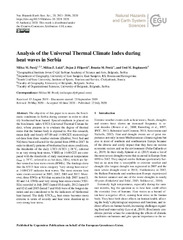Приказ основних података о документу
Analysis of the Universal Thermal Climate Index during heat waves in Serbia
| dc.creator | Pecelj, Milica | |
| dc.creator | Lukić, Milica | |
| dc.creator | Filipović, Dejan | |
| dc.creator | Protić, Branko | |
| dc.creator | Bogdanović, Uroš | |
| dc.date.accessioned | 2021-09-24T15:45:47Z | |
| dc.date.available | 2021-09-24T15:45:47Z | |
| dc.date.issued | 2020 | |
| dc.identifier.issn | 1561-8633 | |
| dc.identifier.uri | https://gery.gef.bg.ac.rs/handle/123456789/1056 | |
| dc.description.abstract | The objective of this paper is to assess the bioclimatic conditions in Serbia during summer in order to identify biothermal heat hazard. Special emphasis is placed on the bioclimatic index UTCI (Universal Thermal Climate Index), whose purpose is to evaluate the degree of thermal stress that the human body is exposed to. For this research, mean daily and hourly (07:00 and 14:00 CET) meteorological data from three weather stations (Zlatibor, Novi Sad and Nig) have been collected for the period from 1998 to 2017. In order to identify patterns of biothermal heat stress conditions, the thresholds of the daily UTCI (UTCI >= 38 degrees C, referred to as very strong heat stress, VSHS) at 14:00 CET are compared with the thresholds of daily maximum air temperature (t(max) >= 35 degrees C, referred to as hot days, HDs), which are further termed as heat wave events (HWEs). The findings show that the UTCI heat stress category "very strong heat stress" at 14:00 CET indicates heat waves. The most extreme heat wave events occurred in 2007, 2012, 2015 and 2017. Moreover, three HWEs at Nis that occurred in July 2007 lasted 3, 10 and 4 d. HWEs and very strong heat stress events (VSHSEs) recorded in July 2007 (lasted 10 d each), 2012 (lasted 9 and 12 d) and 2015 (lasted 7 and 10 d) were of the longest duration and are considered to be the indicators of biothermal heat hazard. The daily UTCI14h heat stress becomes more extreme in terms of severity and heat wave duration up to very strong heat stress. | en |
| dc.publisher | Copernicus Gesellschaft Mbh, Gottingen | |
| dc.relation | info:eu-repo/grantAgreement/MESTD/Integrated and Interdisciplinary Research (IIR or III)/47007/RS// | |
| dc.relation | info:eu-repo/grantAgreement/MESTD/Basic Research (BR or ON)/176017/RS// | |
| dc.relation | info:eu-repo/grantAgreement/MESTD/Basic Research (BR or ON)/176008/RS// | |
| dc.rights | openAccess | |
| dc.rights.uri | https://creativecommons.org/licenses/by/4.0/ | |
| dc.source | Natural Hazards and Earth System Sciences | |
| dc.title | Analysis of the Universal Thermal Climate Index during heat waves in Serbia | en |
| dc.type | article | |
| dc.rights.license | BY | |
| dcterms.abstract | Филиповић, Дејан; Лукић, Милица; Пецељ, Милица; Богдановић, Урош; Протић, Бранко; | |
| dc.citation.volume | 20 | |
| dc.citation.issue | 7 | |
| dc.citation.spage | 2021 | |
| dc.citation.epage | 2036 | |
| dc.citation.other | 20(7): 2021-2036 | |
| dc.citation.rank | M21 | |
| dc.identifier.wos | 000555044500001 | |
| dc.identifier.doi | 10.5194/nhess-20-2021-2020 | |
| dc.identifier.scopus | 2-s2.0-85089405494 | |
| dc.identifier.fulltext | https://gery.gef.bg.ac.rs/bitstream/id/52/1054.pdf | |
| dc.identifier.rcub | https://hdl.handle.net/21.15107/rcub_gery_1056 | |
| dc.type.version | publishedVersion |


